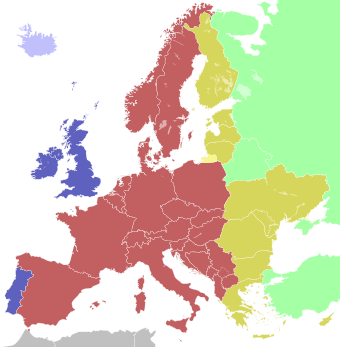Time in Switzerland facts for kids

| blue | Western European Time (UTC+0) Western European Summer Time (UTC+1) |
| light blue | Western European Time (UTC+0) |
| red | Central European Time (UTC+1) Central European Summer Time (UTC+2) |
| yellow | Eastern European Time (UTC+2) Eastern European Summer Time (UTC+3) |
| orange | Kaliningrad Time (UTC+3) |
| green | Further-eastern European Time (UTC+3), a.k.a. Moscow Time |
Switzerland uses a single time zone, which is called Central European Time (CET). This means that Switzerland is one hour ahead of Coordinated Universal Time (UTC+01:00). During the warmer months, Switzerland also uses summer time. This shifts the clock forward by one hour, making it Central European Summer Time (CEST), which is two hours ahead of UTC (UTC+02:00).
Contents
What Time Is It in Switzerland?
Switzerland keeps things simple with just one time zone across the whole country. Most of the year, from late October to late March, Switzerland uses Central European Time (CET). This time is exactly one hour ahead of Coordinated Universal Time (UTC). So, if it's 12:00 PM UTC, it's 1:00 PM in Switzerland.
What is Central European Time (CET)?
Central European Time, or CET, is a common time zone used by many countries in Europe. It's based on the idea of dividing the world into different time zones, each one hour apart. CET is often called UTC+1, meaning it's one hour ahead of the world's main time standard, UTC. Think of UTC as the "master clock" for the entire planet.
What is Daylight Saving Time (DST)?
To make the most of the daylight during spring and summer, Switzerland, like many other countries, uses Daylight Saving Time (DST). This is also known as "summer time." The idea is to move the clocks forward by one hour in spring and then back by one hour in autumn.
In Switzerland, this usually happens on the last Sunday in March. Everyone "springs forward" one hour. So, if it was 2:00 AM CET, it suddenly becomes 3:00 AM CEST. This gives people more daylight in the evenings. When autumn arrives, usually on the last Sunday in October, clocks "fall back" one hour. So, 3:00 AM CEST becomes 2:00 AM CET again.
When Switzerland is using summer time, it's called Central European Summer Time (CEST). This means it's UTC+2, or two hours ahead of Coordinated Universal Time.
How Does DST Affect Daily Life?
When the clocks change for Daylight Saving Time, it can feel a bit strange at first! You might lose an hour of sleep in spring, but you gain an extra hour of daylight in the evening for playing sports or hanging out with friends. In autumn, you gain an hour of sleep, but the evenings get darker earlier. It's something people get used to every year!
Why Does Switzerland Use One Time Zone?
Switzerland is a relatively small country. It's not wide enough from east to west to need more than one time zone. This makes things much easier for everyone living there, as well as for visitors. Imagine if different parts of the country had different times – it would be very confusing for travel and business!
A Little Bit About Time Zones
Time zones were created because of how the Earth spins. The Earth rotates completely once every 24 hours. As it spins, different parts of the world face the sun, which is why we have day and night. Before time zones, every town would set its clocks based on when the sun was highest in the sky. This meant every town had a slightly different time!
How Do Time Zones Work?
This system became a big problem when trains and telegraphs made it possible to travel and communicate quickly across long distances. Imagine trying to make a train schedule if every town had its own time!
To fix this, the world was divided into 24 main time zones, each roughly 15 degrees of longitude wide. The starting point for these time zones is the Prime Meridian, which runs through Greenwich, London. This is where Coordinated Universal Time (UTC) is based. As you travel east from Greenwich, you add an hour for each time zone. As you travel west, you subtract an hour.

